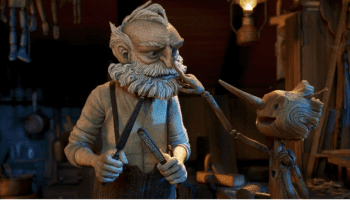
Award-winning film director Guillermo del Toro says he wanted to portray the puppet as a “flawed Messiah” figure in the new film after reflecting on the spiritual themes woven throughout his adaptation of “Pinocchio.”
Carlo Collodi’s 19th-century fairy tale about a mischievous puppet desperate to become a “real boy” has been adapted and retold in many forms, most notably by Walt Disney in 1940. But “Guillermo del Toro’s Pinocchio” takes a much different approach to the classic story.
The stop-motion animated film, featuring the voices of Gregory Mann, Ewan McGregor and Finn Wolfhard, is set in 1930s Italy during Mussolini’s fascist dictatorship. After losing his son, Carlo, in a church bombing, Gepetto carves a wooden boy, Pinocchio, who later comes to life. Gepetto initially resists the puppet, believing his deceased son can never be replaced.
Naive, curious and desperate to prove his worth as a “real boy,” Pinocchio is captured by the evil puppeteer Count Volpe and embarks on a series of dangerous excursions across Italy. Meanwhile, a regretful Gepetto — who realizes he profoundly loves the puppet — and a talking bug, Sebastian J. Cricket, travel far and wide, seeking to reunite with Pinocchio.
Equal parts funny and whimsical, the film examines the topics of love, loss, grief and the meaning of life. And woven throughout the film are biblical allegories and illusions — something del Toro, who was raised Catholic, told The Christian Post is an integral part of the story.
“Callodi always saw Pinocchio as a flawed Messiah,” del Toro said, adding that he intended the relationship between Gepetto and Pinocchio to reflect the relationship between Jesus Christ and His Father, a sometimes complicated one yet defined by deep and unconditional love.
In one particularly poignant scene, Gepetto brings Pinocchio to church, which had been shattered by a bomb, to fix the crucifix of Jesus. Pinocchio, who has been mocked and shunned by the villagers, stares at the wooden depiction of Christ. “Everybody likes Him,” Pinocchio says, looking at the figure. “They were all singing to Him. He’s made of wood, too. Why do they like him and not me?” del Toro told reporters, “The conversation between Pinocchio and his father in church … is full of delicate, incredible nuance.”
When Gepetto loses his son, he wrestles with God: “Why won’t you listen to my prayers?” Geppetto shouts to the sky. “Why?!” The Mexican filmmaker, who was raised by his Catholic grandmother, said throughout the film Pinocchio is meant to be a Christ-like figure, both subtly and blatantly. He loses an arm — the same arm Geppetto’s crucifix carving of Jesus lost in the bombing raid. Later, the puppet is tied to a cross, about to be killed.
In another scene, Count Volpe attempts to convince Pinocchio to join his carnival by taking him to a balcony and showing him a birdseye view of the scenery. “You shall see all the nations of the earth as they bow at your feet,” Volpe tells the puppet, reflecting Satan’s temptation of Jesus in Matthew 4:1-11.
And prevalent throughout “Pinocchio,” del Toro said, are the themes of grace, forgiveness and sacrifice. Pinocchio learns to forgive Gepetto for his initial distaste for the puppet. Gepetto, in turn, forgives Pinocchio for his disobedience. Both characters, in the end, are willing to make the ultimate sacrifice for one another.
Despite its PG rating, the film doesn’t shy away from the topics of grief, death and loss. It also includes some violent scenes — Pinocchio “dies” several times — and Gepetto turns to alcohol following his son’s death. There is also one exclamation of “oh my g*d.” But the film includes topics worthy of discussion; as del Toro told NPR, “It is not sanitized for kids, but kids can watch it if their parents talk to them.”


